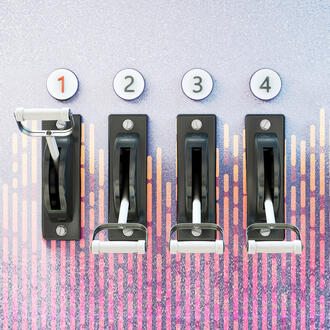Credit: Steve Sauer
Ideas Made to Matter
How Dick’s Sporting Goods stores are thriving in a digital world
By
Dick’s Sporting Goods launched more than 70 years ago with one small storefront in Binghamton, N.Y. Today the company has grown into an empire with more than 700 stores in 48 states and $8.5 billion in revenue in 2018.
In the age of online shopping and same-day shipping, stores still play a big part in the company’s success, according to Dick’s executives who spoke at the recent MIT Sloan Retail Conference. In fact, about 85% of the company’s sales take place in person.
“Brick and mortar is just as relevant as it's always been,” said Kristin Boyle, the company’s vice president of insights and analytics.
That’s not to say stores haven’t changed in response to digital trends and customer behavior.
“What you have to know, and what smart retailers have really adapted to, is that the role of brick and mortar is very different than it was five or 10 years ago,” Boyle said. “Some understanding of what that role is, and reacting to it and designing experiences around it, [is how] you become successful.”
Dick’s has been rethinking its relationship with customers — or “athletes,” in the company’s parlance — and transforming its physical spaces in response to digital trends, according to Steve Miller, senior vice president of strategy and analytics. Dick’s and other companies are facing a transformative challenge: “how to compete in the age of Amazon, where convenience is being redefined every day,” Miller said.
From a celebrity-studded fashion show and working with new brands to batting cages in stores, here’s how Dick’s Sporting Goods retail stores are evolving.
Shifting the role of stores to meet customer needs
Boyle said customers in the digital era visit stores for three key reasons:
1. To fill an immediate need. Sometimes two-day, or even one-day, shipping isn’t quick enough. When parents find out their child’s soccer cleats don’t fit the night before the first practice, Boyle said, they depend on being able to visit a store.
2. To talk to an expert. The internet provides a great deal of information, but it can be hard to tell the good from the bad. Retail staff with expertise increasingly serve as consultants to help people figure out what they need, Boyle said.
3. To have a tangible experience. Customers often want to test equipment like baseball bats or golf clubs before buying. Dick’s has made it easier to do so through measures like putting batting cages in stores. “Immersive and product-focused experiences are a way that we can really bring the purpose of retail to life in a new way,” Boyle said.
Adopting the right in-store technology
With mobile orders and online technology top of mind for the company, Dick’s has focused on transforming stores to meet digital behaviors. In-store technology has to serve a purpose, Boyle said. “We haven't put technology in stores just for the sake of having it there,” she said. “It has to tie back to one of those reasons.”
For example, an app allows customers to scan shoes and see all the sizes in stock. The company has also focused on perfecting its “buy online, pick up in the store” option. “This truly is the intersection between the digital and the physical. It's the perfect blend,” Boyle said.Having a robust, profitable physical retail business gives strength to new technological investments. “It funds investment in technology that other companies are not able to do,” Boyle said. “When you develop technology, you can roll it out to 800 fantastic stores and almost have scale instantaneously.”
Creating experiences
Customer experiences are a blend of physical and digital strategies, Boyle said. Last October, Dick’s held an outdoor fashion show in New York City, with models that included former baseball player Alex Rodriguez, women’s soccer star Carli Lloyd, and reality star Demi Burnett from The Bachelor. Another event, the Dick’s Outdoor Adventure Tour, involved turning store parking lots into interactive sales spaces with bike tracks to help customers to test ride bikes and enormous paddle pools for trying out kayaks.
Online news coverage of events like the fashion show draw customers to stores and the company website, Boyle said, and events result in increased sales in the associated stores as well as in surrounding ZIP codes and online.
Meeting customers where they are
85% of sales at Dick's Sporting Goods are made in physical stores.
Not only are customers doing more shopping online, but online habits are changing over time. In the last few years, Miller said, customers have shifted from starting most product searches on Google to starting searches on Amazon’s website. “If you're not on Amazon from a product search perspective, you've got to really think long and hard about how you get traffic,” he said.
Boyle said the company thinks about interacting with customers where they spend their time, both physically and online. “You don’t want to be waiting for the Google search to be getting someone to your website,” she said. “You want to be thinking about where and when can I interact with them? When are they thinking about sporting goods and their activities?” The company also tries to interact with coaches, parents, and other people connected to athletes.
Dick’s marketing strategy has included launching sponsored games on Snapchat and holiday television ads featuring products coming to life that were also posted on Instagram. “It’s a way for us to be in a space that feels fun and engaging but still reminds the consumer about the footwear that they might be considering at that point in time,” Boyle said.
Managing brand relationships
Partnering with brands is a longstanding part of sales strategy at Dick’s, which was one of the first companies to carry Nike products, Miller said. Today the company aims to create strong private brands as well as build relationships with digitally native companies and national brands.
Dick’s aims to reach $2 billion in private label sales in the next couple years, Miller said, through brands like CALIA, a high-quality athleisure brand developed with Carrie Underwood, and DSG, a new line of quality basics and staples that Miller said will likely be the company’s biggest brand in the near future.
“We feel like [if] we can master that trinity between great national brand relationships, investments with digitally native brands, and then building our own brand portfolio … we’re going to be well-positioned for the future,” Miller said.



